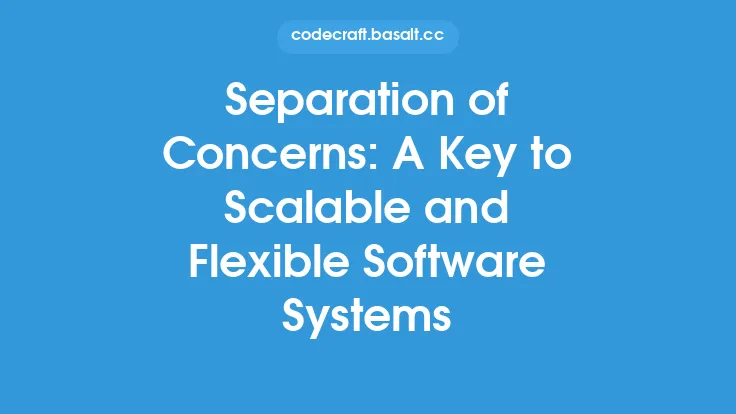When dealing with complex systems, software developers often encounter the challenge of integrating different components, libraries, or frameworks that have incompatible interfaces. This is where adapter and facade patterns come into play, providing a way to simplify complex systems by bridging the gap between incompatible interfaces and hiding the complexity of subsystems. In this article, we will delve into the world of adapter and facade patterns, exploring their definitions, benefits, and use cases, as well as providing examples and code snippets to illustrate their implementation.
Introduction to Adapter Pattern
The adapter pattern is a structural design pattern that allows two incompatible objects to work together by converting the interface of one object into an interface expected by the other object. It acts as a bridge between two interfaces, enabling them to communicate with each other seamlessly. The adapter pattern is commonly used when we want to use an existing class, but its interface does not match the interface required by the client code. By using an adapter, we can adapt the existing class to work with the client code without modifying the existing class.
Introduction to Facade Pattern
The facade pattern is another structural design pattern that provides a simplified interface to a complex system of classes, libraries, or frameworks. It hides the complexity of the subsystem from the client code, providing a single interface through which the client can access the subsystem. The facade pattern is useful when we want to provide a unified interface to a set of interfaces in a subsystem, making it easier to use and understand the subsystem.
Benefits of Adapter and Facade Patterns
The adapter and facade patterns offer several benefits, including:
- Improved compatibility: The adapter pattern allows incompatible objects to work together, while the facade pattern provides a unified interface to a complex subsystem, making it easier to integrate with other components.
- Reduced complexity: The facade pattern hides the complexity of a subsystem, making it easier to use and understand, while the adapter pattern simplifies the interaction between incompatible objects.
- Increased flexibility: Both patterns enable us to change the implementation of a subsystem or an object without affecting the client code, making it easier to maintain and evolve the system.
- Reusability: The adapter and facade patterns promote reusability by allowing us to use existing classes and subsystems in new contexts, reducing the need to duplicate code.
Use Cases for Adapter and Facade Patterns
The adapter and facade patterns have a wide range of use cases, including:
- Database integration: When integrating different databases with incompatible interfaces, the adapter pattern can be used to provide a unified interface to the databases.
- Third-party libraries: When using third-party libraries with incompatible interfaces, the adapter pattern can be used to adapt the libraries to work with the client code.
- Complex subsystems: The facade pattern can be used to provide a simplified interface to complex subsystems, such as payment gateways or file systems.
- Legacy system integration: When integrating legacy systems with modern systems, the adapter and facade patterns can be used to provide a unified interface to the legacy systems.
Implementing Adapter and Facade Patterns
To illustrate the implementation of the adapter and facade patterns, let's consider an example. Suppose we have a client code that requires a `PaymentGateway` interface to process payments, but we have two different payment gateways, `PayPal` and `Stripe`, with incompatible interfaces. We can use the adapter pattern to adapt the `PayPal` and `Stripe` interfaces to work with the client code.
// Target interface
public interface PaymentGateway {
void processPayment(String amount);
}
// Adaptee interface
public interface PayPal {
void pay(String amount);
}
// Adaptee interface
public interface Stripe {
void charge(String amount);
}
// Adapter class
public class PayPalAdapter implements PaymentGateway {
private PayPal payPal;
public PayPalAdapter(PayPal payPal) {
this.payPal = payPal;
}
@Override
public void processPayment(String amount) {
payPal.pay(amount);
}
}
// Adapter class
public class StripeAdapter implements PaymentGateway {
private Stripe stripe;
public StripeAdapter(Stripe stripe) {
this.stripe = stripe;
}
@Override
public void processPayment(String amount) {
stripe.charge(amount);
}
}
// Client code
public class PaymentProcessor {
public void processPayment(PaymentGateway paymentGateway, String amount) {
paymentGateway.processPayment(amount);
}
}
// Usage
public class Main {
public static void main(String[] args) {
PayPal payPal = new PayPalImpl();
Stripe stripe = new StripeImpl();
PayPalAdapter payPalAdapter = new PayPalAdapter(payPal);
StripeAdapter stripeAdapter = new StripeAdapter(stripe);
PaymentProcessor paymentProcessor = new PaymentProcessor();
paymentProcessor.processPayment(payPalAdapter, "10.0");
paymentProcessor.processPayment(stripeAdapter, "20.0");
}
}
In this example, we define the `PaymentGateway` interface as the target interface, and the `PayPal` and `Stripe` interfaces as the adaptee interfaces. We then create adapter classes, `PayPalAdapter` and `StripeAdapter`, that implement the `PaymentGateway` interface and adapt the `PayPal` and `Stripe` interfaces to work with the client code.
Similarly, we can use the facade pattern to provide a simplified interface to a complex subsystem. Suppose we have a complex subsystem that provides multiple interfaces for file operations, such as `FileReader`, `FileWriter`, and `FileDeleter`. We can use the facade pattern to provide a unified interface to the subsystem, making it easier to use and understand.
// Subsystem interfaces
public interface FileReader {
String read(String fileName);
}
public interface FileWriter {
void write(String fileName, String content);
}
public interface FileDeleter {
void delete(String fileName);
}
// Facade interface
public interface FileFacade {
String readFile(String fileName);
void writeFile(String fileName, String content);
void deleteFile(String fileName);
}
// Facade class
public class FileFacadeImpl implements FileFacade {
private FileReader fileReader;
private FileWriter fileWriter;
private FileDeleter fileDeleter;
public FileFacadeImpl(FileReader fileReader, FileWriter fileWriter, FileDeleter fileDeleter) {
this.fileReader = fileReader;
this.fileWriter = fileWriter;
this.fileDeleter = fileDeleter;
}
@Override
public String readFile(String fileName) {
return fileReader.read(fileName);
}
@Override
public void writeFile(String fileName, String content) {
fileWriter.write(fileName, content);
}
@Override
public void deleteFile(String fileName) {
fileDeleter.delete(fileName);
}
}
// Client code
public class FileProcessor {
public void processFile(FileFacade fileFacade, String fileName, String content) {
fileFacade.writeFile(fileName, content);
String fileContent = fileFacade.readFile(fileName);
System.out.println(fileContent);
fileFacade.deleteFile(fileName);
}
}
// Usage
public class Main {
public static void main(String[] args) {
FileReader fileReader = new FileReaderImpl();
FileWriter fileWriter = new FileWriterImpl();
FileDeleter fileDeleter = new FileDeleterImpl();
FileFacade fileFacade = new FileFacadeImpl(fileReader, fileWriter, fileDeleter);
FileProcessor fileProcessor = new FileProcessor();
fileProcessor.processFile(fileFacade, "example.txt", "Hello World!");
}
}
In this example, we define the `FileReader`, `FileWriter`, and `FileDeleter` interfaces as the subsystem interfaces, and the `FileFacade` interface as the facade interface. We then create a facade class, `FileFacadeImpl`, that implements the `FileFacade` interface and provides a unified interface to the subsystem.
Conclusion
In conclusion, the adapter and facade patterns are powerful tools for simplifying complex systems by bridging the gap between incompatible interfaces and hiding the complexity of subsystems. By using these patterns, we can improve compatibility, reduce complexity, increase flexibility, and promote reusability in our software systems. Whether we are integrating different databases, third-party libraries, or complex subsystems, the adapter and facade patterns provide a way to provide a unified interface to incompatible interfaces, making it easier to use and understand the system. By applying these patterns in our software development, we can create more maintainable, scalable, and efficient systems that meet the needs of our users.





